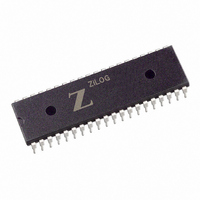Z85C3008PSG Zilog, Z85C3008PSG Datasheet - Page 58

Z85C3008PSG
Manufacturer Part Number
Z85C3008PSG
Description
IC 8MHZ Z8500 CMOS SCC 40-DIP
Manufacturer
Zilog
Series
SCCr
Specifications of Z85C3008PSG
Processor Type
Z80
Features
Error Detection and Multiprotocol Support
Speed
8MHz
Voltage
5V
Mounting Type
Through Hole
Package / Case
40-DIP (0.620", 15.75mm)
Maximum Operating Temperature
+ 70 C
Minimum Operating Temperature
0 C
Mounting Style
Through Hole
Cpu Speed
8MHz
Digital Ic Case Style
DIP
No. Of Pins
40
Supply Voltage Range
5V
Operating Temperature Range
0°C To +70°C
Svhc
No SVHC (18-Jun-2010)
Base Number
85
Rohs Compliant
Yes
Clock Frequency
8MHz
Lead Free Status / RoHS Status
Lead free / RoHS Compliant
Other names
269-3930
Q2456016A
Z85C3008PSG
Q2456016A
Z85C3008PSG
Available stocks
Company
Part Number
Manufacturer
Quantity
Price
Company:
Part Number:
Z85C3008PSG
Manufacturer:
ZILOG
Quantity:
6 100
Company:
Part Number:
Z85C3008PSG
Manufacturer:
Zilog
Quantity:
6
Company:
Part Number:
Z85C3008PSG
Manufacturer:
TOSHIBA
Quantity:
3 500
Part Number:
Z85C3008PSG
Manufacturer:
ZILOG
Quantity:
20 000
Company:
Part Number:
Z85C3008PSGSCC
Manufacturer:
ZILOG
Quantity:
2
- Current page: 58 of 317
- Download datasheet (4Mb)
UM010901-0601
In the Request mode, /REQ will follow the state of the
transmit buffer even though the transmitter is disabled.
Thus, if /REQ is enabled before the transmitter is enabled,
the DMA may write data to the SCC before the transmitter
is enabled. This does not cause a problem in Asynchro-
nous mode, but may cause problems in Synchronous
modes because the SCC sends data in preference to flags
or sync characters. It may also complicate the CRC initial-
ization, which cannot be done until after the transmitter is
enabled. On the ESCC, this complication can be avoided
in SDLC mode by using the Automatic SDLC Opening Flag
Transmission feature and Auto EOM reset feature which
also resets the transmit CRC. (See section 4.4.1.2 for de-
tails). Applications using other synchronous modes should
enable the transmitter before enabling the /REQ function.
With only one exception, the /REQ pin directly follows the
state of the Transmit FIFO (for ESCC, as programmed by
WR7' D5) in this mode. The one exception occurs in syn-
chronous modes at the end of a CRC transmission. At the
end of a CRC transmission, when the closing flag or sync
character is loaded into the Transmit Shift Register, /REQ
is pulsed High for one PCLK cycle. The DMA uses this fall-
ing edge on /REQ to write the first character of the next
frame to the SCC.
2.5.2.4 DMA Request On Receive
The Request On Receive function is selected by setting D6
and D5 of WR1 to 1 and then enabling the function by set-
ting D7 of WR1 to 1. In this mode, the /W//REQ pin carries
Rx Character
Read Strobe
Available
to FIFO
W/REQ
(=REQ)
Empty
FIFO
Figure 2-32. DMA Receive Request Assertion
Character Available
the /REQ signal, which is active Low. When REQ on Re-
ceive is selected, but not yet enabled (WR1 D7=0), the
/W//REQ pin is driven High. When the enable bit is set,
/REQ goes Low if the Receive FIFO contains a character
at the time, or will remain High until a character enters the
Receive FIFO. Note that the /REQ pin follows the state of
the Receive FIFO even though the receiver is disabled.
Thus, if the receiver is disabled and /REQ is still enabled,
the DMA transfers the previously received data correctly.
In this mode, the /REQ pin directly follows the state of the
Receive FIFO with only one exception. /REQ goes Low
when a character enters the Receive FIFO and remains
Low until this character is removed from the Receive FIFO.
The SCC generates only one falling edge on /REQ per
character transfer requested (Figure 2-32). The one ex-
ception occurs in the case of a special receive condition in
the Receive Interrupt on First Character or Special Condi-
tion mode, or the Receive Interrupt on Special Condition
Only mode. In these two interrupt modes, any receive
character with a special receive condition is locked at the
top of the FIFO until an Error Reset command is issued.
This character in the Receive FIFO would ordinarily cause
additional DMA Requests after the first time it is read.
However, the logic in the SCC guarantees only one falling
edge on /REQ by holding /REQ High from the time the
character with the special receive condition is read, and
the FIFO locked, until after the Error Reset command has
been issued.
SCC™/ESCC™ User’s Manual
Interfacing the SCC/ESCC
2-39
2
Related parts for Z85C3008PSG
Image
Part Number
Description
Manufacturer
Datasheet
Request
R

Part Number:
Description:
Manufacturer:
Zilog, Inc.
Datasheet:

Part Number:
Description:
Cmos Scc Serial Communications Controller
Manufacturer:
ZiLOG Semiconductor
Datasheet:

Part Number:
Description:
Communication Controllers, ZILOG INTELLIGENT PERIPHERAL CONTROLLER (ZIP)
Manufacturer:
Zilog, Inc.
Datasheet:

Part Number:
Description:
KIT DEV FOR Z8 ENCORE 16K TO 64K
Manufacturer:
Zilog
Datasheet:

Part Number:
Description:
KIT DEV Z8 ENCORE XP 28-PIN
Manufacturer:
Zilog
Datasheet:

Part Number:
Description:
DEV KIT FOR Z8 ENCORE 8K/4K
Manufacturer:
Zilog
Datasheet:

Part Number:
Description:
KIT DEV Z8 ENCORE XP 28-PIN
Manufacturer:
Zilog
Datasheet:

Part Number:
Description:
DEV KIT FOR Z8 ENCORE 4K TO 8K
Manufacturer:
Zilog
Datasheet:

Part Number:
Description:
CMOS Z8 microcontroller. ROM 16 Kbytes, RAM 256 bytes, speed 16 MHz, 32 lines I/O, 3.0V to 5.5V
Manufacturer:
Zilog, Inc.
Datasheet:

Part Number:
Description:
Low-cost microcontroller. 512 bytes ROM, 61 bytes RAM, 8 MHz
Manufacturer:
Zilog, Inc.
Datasheet:

Part Number:
Description:
Z8 4K OTP Microcontroller
Manufacturer:
Zilog, Inc.
Datasheet:

Part Number:
Description:
CMOS SUPER8 ROMLESS MCU
Manufacturer:
Zilog, Inc.
Datasheet:

Part Number:
Description:
SL1866 CMOSZ8 OTP Microcontroller
Manufacturer:
Zilog, Inc.
Datasheet:











